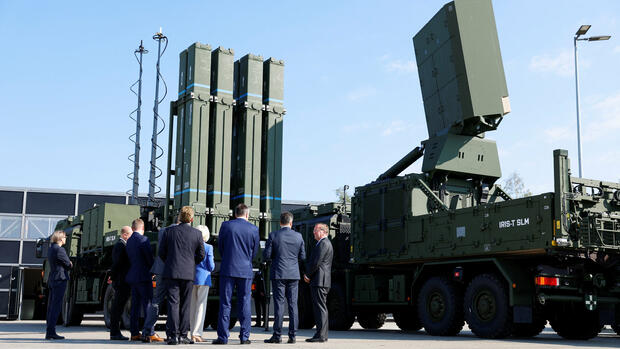The manufacturer promises an almost 100% kill rate.
(Photo: Reuters)
Berlin Estonia and Latvia are investing massively in their security and are joining the joint air defense initiative European Sky Shield (Essi) initiated by Chancellor Olaf Scholz (SPD). The Latvian Defense Minister Inara Murniece, her Estonian colleague Hanno Pevkur and the German department head Boris Pistorius (SPD) signed a corresponding declaration of intent on Monday at the site of the arms manufacturer Diehl Defense in Röthenbach, Bavaria.
Both countries also want to purchase Iris-T SLM air defense systems from Diehl Defense, which are expected to be ready for use in 2025. Neither the minister nor the manufacturer mentioned a number of units.
Germany is also purchasing six fire units of the system for 950 million euros; a corresponding contract between the Bundeswehr procurement office and the manufacturer was signed in June. The first examples are expected to enter service in the middle of next year. In addition, Germany has already delivered two Iris-T-SLM systems to Ukraine, with six more to follow.
Largest defense investment in Estonian history
Pevkur spoke of a “historic moment” not only for Estonia, Latvia and Germany, but for all of Europe, in whose security we are investing. The purchase of air defense is by far the largest defense investment in Estonia’s history.
The Estonian Defense Minister said the contract volume for Diehl is expected to be almost one billion euros. This would make Germany the country’s largest arms partner, ahead of the USA.
>> Read here: Diehl is growing strongly – also because of arms deliveries to Ukraine
One of the biggest lessons from the Ukraine war is that you have to maintain control of your own airspace, explained Pevkur. The Russian aggressor does not distinguish between civilian and military targets, said Murniece. That is why it is important to invest in security and air defense.
The purchase of the Iris-T SLM system is the largest defense investment in Estonia’s history.
(Photo: Reuters)
As the politicians emphasized, Estonia will spend almost 3.3 percent of its economic output on defense next year; in Latvia it is currently 2.3 percent, but the proportion is expected to grow to three percent.
Federal Defense Minister Pistorius welcomed the declaration of intent by both countries to join Essi with their air defense plans. “This will without a doubt strengthen European air defense,” Pistorius said.
NATO weapon systems should be usable together
Joint procurement enables synergies and economies of scale: “We save money when we do it together,” says Pistorius. There is also potential for joint training and maintenance of the systems, and the interoperability of the armed forces of the individual countries is increasing. This is also a lesson from the Ukraine war. The NATO states should also be able to use the various weapon systems together.
>> Read here: Europe’s “military zoo” – The EU must finally bundle its defense policy
15 nations signed the agreement on the European Sky Shield Initiative at NATO headquarters in Brussels in October 2022. Four other countries have now joined. The aim is to jointly procure and operate weapon systems that can be used to combat drones, cruise missiles, aircraft or intercontinental ballistic missiles at different altitudes.
Iris-T SLM can be used against targets at altitudes of up to 20 kilometers and has a range of up to 40 kilometers. According to Diehl, the Ukrainian military reports an “almost 100 percent kill rate” of the system. A fire unit consists of the components launcher, radar and command post. In addition, there are support elements such as workshop, spare parts and reloading vehicles.
More: Hensoldt boss Thomas Müller – “Uncle Sam will no longer hold the protective shield over Europe”
